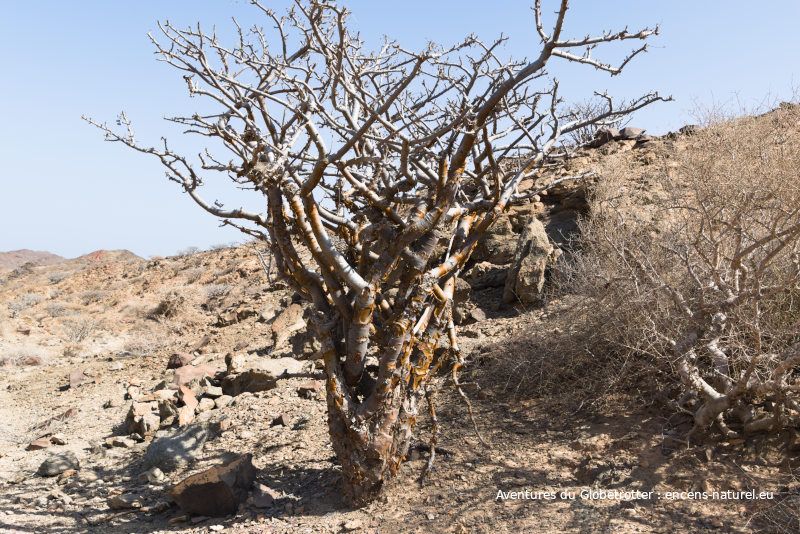The Dhofar region


Ridge of the mountain range
In 2000, UNESCO recognized the historic significance of this « Land of frankincense » by inscribing it on its World Heritage List 3 . It is in the region of Dhofar, south of Oman, that the highest quality resin is produced in the world. It is known as Royal Hojari. As an endemic plant, it benefits from exceptional weather conditions. It is used in perfumery but also for its medicinal virtues by the Omanis.
The environment of this region has an effect on the chemotype of the boswellia sacra making it not only a much more fragrant resin incense, but also is considered to contain higher levels of boswellic acid.
Source and quality
Plateau & Desert

Best

good
On the semi-desert high plateau, the trees, with several stems, are shorter than those of the coastal plain. The trees grow in an extremely dry climate 3b .
On this limestone plateau, the climate is arid. It is on this high plateau that the frankincense tree thrives.
A semi-desert high plateau contemplates the coastline along a steep rocky barrier.
On this limestone plateau, the climate is arid, punctuated by the waves of monsoons periodically watering the coastal fringe. It is on this plateau that the frankincense tree thrives.
It is necessary to wait at least the age of nine to ten years, so that the tree reaches its adult size and produces a good quality resin. Flowering, hermaphrodite flowers 3a , takes place in early April.

Coastal plain

Fresh

Old
Production areas
The frankincense from the mountain side is called Hojari Frankincense named after the Hajar Mountain. Hajar is the Arabic word for stone. The mountains are refered to as “Al Jebel al Hajar”, which means “the stone mountain”.

Plant species have a certain characteristic. They are highly dependent on climate, availability of water, quality of sunlight, temperature and soil. Thus, the Boswellia in Oman can vary in many ways.
The peak of the mountain range is a very important natural element. Rains and winds from the coastal plain fade over the ridge.
Humidity levels drop sharply, leaving a semi-desert soil with desert and limestone, favoring the production of high-quality frankincense.
The famous Hojari frankincense is produced in an area located 25 km from the hinterland of Jebel Samhan, between 1000 and 1500m altitude. (between points B and C)
Beyond this area 500 to 1000m above sea level, the density of Boswellia sacra begins to decrease towards the interior of the desert (between points C and D).
The rains are occasional. The resins obtained from trees are not damaged by the rains. However too much drought could kill trees because their roots could not receive the necessary nutrients.4
Quality
Harvest of frankincense
In the Sultanate of Oman
The cultivation of frankincense is a know-how that has been handed down from generation to generation for decades and which we inherit proudly. Harvesting is done by a shallow incision in the bark of the male tree by removing a narrow band. A sap flows out and coagulates on contact with the air, then it is picked up by hand. A succession of 3 passes, spaced from 10 to 15 days apart, is made on the incisions. The third pass gives the best resin.
At the place of harvest, after the resin has been collected and collected in bags, the producers store it in an excavation, a cave or some sort of camp, to accumulate it for a certain time. Finally, after collecting sufficient quantities, it is sent to the village or town, where it is classified.
Every five to six years, the trees are left as they are for a few years to obtain a better quality resin.
Harvesting is carried out according to geographic areas. The harvest, on the trees located on the coastal plain or during the monsoon, is done from the end of March to June, approximately. For those located behind the Dhofar mountain (desert area), the resin is picked from April to September. This second harvest is called "white incense", as opposed to "brown incense", harvested only on the coastal plain after winter incisions.. A tree can produce about 3 to 4 kg per season. According to studies, from Environment Society of Oman (ESO) 2 the incisions - which must be spaced apart by about thirty centimeters - are made on the east and west sides of the tree to allow sufficient exposure to the sun for rapid drying of the resin.

An ancient technique
A unique tool with a wooden handle and an iron spatula at its end, used by the incense producer Dhofari (Bedouin), to « peel » the bark. Sometimes the tool may be provided with a spatula at each of its ends.
As soon as an incision is made, the sap begins to surface. The optimal size of the tapping must not exceed 12 cm². The plant or tree that produces saps or resins is it serves as a defence mechanism to seal off its injury, to prevent desiccation, and to protect against insect and fungal attacks, as well as decay.
Crédits
- Interview to Annette Patzelt (Oman Botanic Garden’s Director of Science)
- Burseraceae of Dhofar by Ahmed Mohammed Mustahil Al Kathiri
- Phytogeographic zones of Dhofar by Mauro Raffaelli & Marcello Tardelli
- Boswellia sacra Flueck in the Hasik area, Mauro Raffaelli, Stefano Mosti & Marcello Tardelli
